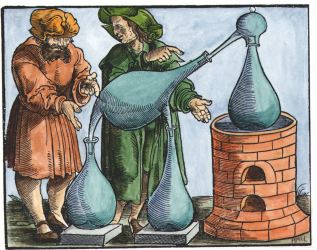I just discovered a book by Philip Ball, Bright Earth: The Invention of Colour. This was originally published in 2001, but recently reissued in 2008. It is essentially a book on the history of artists' pigments and their methods of working with colours. It is not a scholarly work, but rather a compilation of research by Philip Ball, who was trained in chemistry, into this negelected area. Perhaps the book lacks structure and focus, but Ball generously shares all his research in a breathless, enthusiastic survey. There are so many interesting facts about pigments in this book, and the author devotes quite a bit of space to exploring the links between alchemy and pigments.
As an example the author considers the way in which vermilion became so very much used in 15th century paintings. This was partly due to the artificial creation of vermilion originally discovered by alchemists of that period. This produced a very fine powdered form, purer than that obtained from mineral vermilion ore. Also there was a need for an intense blue during that period. This required ultramarine made from lapis lazuli from Afghanistan. This was so expensive. However, other blues were discovered using similar minerals found in Germany. These needed to be chemically manipulated with acids to produce the intense blue necessary. Durer used these German blues (as well as ultramarine). They were called Bergblau.
I found this book to be a good compilation of information that is not easily available.
Last edited on Mon May 26th, 2008 03:56 pm by adammclean
|

